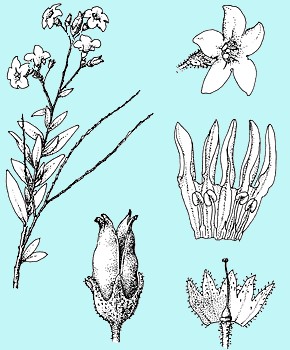
Synonymy
Anthocercis fasciculata F. Muell., Fragm. Phytogr. Austral. 1: 122 (1859)
T: Phillips River, south-western W.A., Maxwell s.n.; syn: BM, K, MEL.
Description
Erect shrub to 3.5 m, sparsely to moderately pubescent with simple, glandular hairs.
Leaves narrowly elliptic to narrowly obovate, sessile, the upper ones linear, 11–45 mm long, 3–10 mm wide, (the juvenile leaves larger), entire.
Inflorescence cyme-like; pedicels 4–16 mm long. Calyx 3–5 mm long. Corolla 9–16 mm long, white; lobes ovate, elliptic or oblong, truncate, 4–9 mm long. Stamens 4–6 mm long.
Capsule ellipsoid to ovoid, often slightly apiculate, 6–9 mm long. Seeds 1.4–2 mm long.
Distribution and ecology
A rare species, endemic to the Fitzgerald River National Park, south-western W.A.
Grows in sandy soil on rocky quartzitic ranges.
Selected specimens
W.A.: East Mt Barren, C.A. Gardner 2949 (PERTH); Whoogarup Range, A.S. George 7200 (PERTH); East Mt Barren, 14 Oct. 1961, J.H. Willis (MEL).
Derivation of epithet
From fasciculatus, Latin for bundled, presumably a reference to the grouping of the flowers.
Images and information on web
See the FloraBase treatment at http://florabase.calm.wa.gov.au/browse/profile/6944
Pharmacology: A discussion of the tropane alkaloids which occur in Anthocercis and other Anthocercideae can be found in Griffith & Lin (2000).
Ref: W.J. Griffin & G.D. Lin (2000). Chemotaxonomy and geographical distribution of tropane alkaloids. Phytochemistry 53: 627–628.
References to the possible toxic properties of Anthocercis species can be found with a search in the
FDA Poisonous Plant DatabasePlant status (if any)
Originally classified as Risk Code 2KCa (Briggs & Leigh, Rare or Threatened Australian Plants, 1995) and P2 (CALM Priority Flora Code 1994).
Now declared as Priority 4 - Rare based on Atkins (2008). See http://florabase.calm.wa.gov.au/conservationtaxa
Atkins, K.J. (2008). Declared Rare and Priority Flora List for